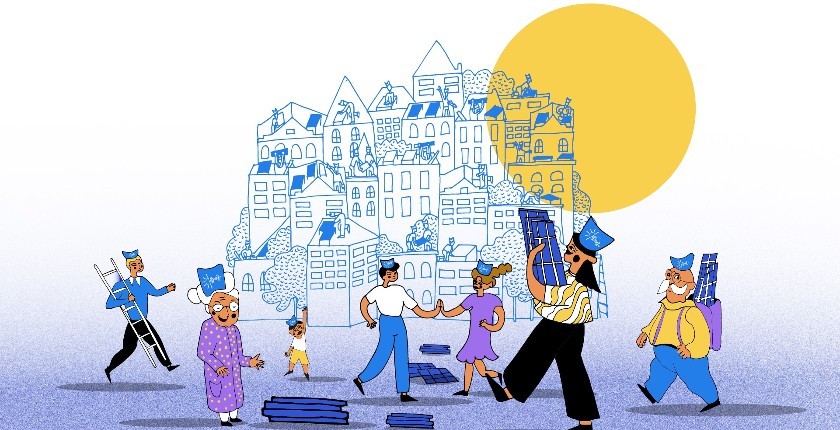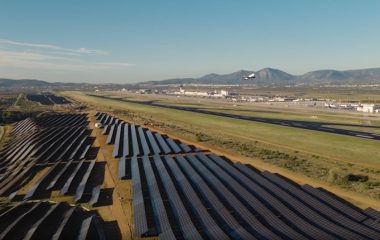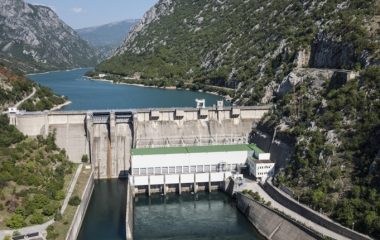
Photo: Elektropionir
Just like in any other area of human activity, small steps can make a great difference in the energy sector as well. Energy cooperative Elektropionir is building Serbia’s first two cooperative power plants, located on Mt. Stara Planina. Although their capacity is just 6 kW each, these two power plants suggest that greater citizen participation in energy production in Serbia is indeed possible. Balkan Green Energy News has spoken to Elektropionir’s Ana Džokić, a pioneer of this model in the country, about how citizens can team up in cooperatives and become energy producers. Ushering in a new spirit of citizen participation, the Elektropionir energy cooperative is an inspiring example of good practice, with a well-deserved place in the series Energy transition champions in the Western Balkans.
Elektropionir, one of the first energy cooperatives in the region, launched a crowdfunding campaign earlier this year to build two solar power plants on Mt. Stara Planina, in the villages of Dojkinci and Temska. The necessary funding was raised during the summer, with donations even exceeding the target. At the moment, the cooperative is waiting for the permitting procedure to be completed and preparing the installation, so that the power plants can be built and put in operation by spring 2023.
Revenues from the sale of electricity will go towards covering the needs of the local community, according to Ana Džokić.
What is an energy cooperative, and who makes up Elektropionir?
Elektropionir is an energy cooperative, not an association, explains Džokić. Legally, it’s a different type of organization, whose aim is to shift the focus from the civil sector to another field – citizen energy production.
“Marc Neelen and I have been involved in a regional residential cooperative project for years. In the course of our work, we brought up the topic of energy efficiency and energy production within residential cooperatives. On the other hand, we installed a small power plant on the roof of our house back in 2016,” says Džokić.

Ana Džokić, Elektropionir
Personal experience, combined with the idea that residential buildings can produce citizen energy, was what initiated the creation of the energy cooperative, she says. Džokić notes that people with different backgrounds joined Elektropionir, people who were engaged in activism and research concerning the energy transition and climate change.
Džokić: We teamed up out of enthusiasm and set out to do all this, but with the idea to turn it into a cooperative business
“Interestingly, I didn’t know anyone until the moment we started working on the cooperative. We got together as a team and went into all this out of enthusiasm, but with the idea of turning it all into a cooperative business. Elektropionir was created with the idea of turning research, education and similar activities into energy production. That was our main drive,” she says.
In Europe as well, for example in Germany, Denmark, the Netherlands, and Spain, energy cooperatives were created with similar motives, but that happened one, two, or three decades ago. Another important reason was the “slow response of the states themselves” in the energy transition processes. Cooperatives, in their own way, aim to push and speed up those processes.
Education and the symbolic launch of a renewable energy cooperative
Elektropionir was founded in 2019, and after the first year of operation, the cooperative launched an educational course on solar technology.
“However, since our primary goal was energy production, we were looking for a place for a symbolic launch, and we picked Stara Planina, because of the victory that was won there in 2021 against the construction of small hydropower plants. They were a thorn in the side of the local population, and they gave a bad name to renewable energy sources,” Džokić explains.
The two solar power plants will be set up on the roofs of the local council building in Temska and on the cultural center in the village of Dojkinci.
“We have built a relationship between three sides. The City of Pirot, as the owner of the buildings, local associations, which will use the buildings and the revenues from the power plants, and Elektropionir, which brings know-how to the table and which includes a wide range of individuals and organizations that have supported the project, called Solarna Stara. The three sides have agreed to allocate the revenues, annually, to certain local initiatives and projects,” says Džokić.
Models to democratize energy
In some countries, energy cooperatives and energy communities are the same thing, and in some, they are not. Serbia has introduced energy communities through a law, as is the case in the EU. However, their legal form is quite unclear, and for now their legal definition is not elaborate enough, according to Džokić.
Energy communities can bring together different actors, from individuals, organizations, and companies to local self-governments, in order to produce energy for local use. They are tied to a certain area.
However, Elektropionir has members from several cities and smaller towns in Serbia and is not tied to a specific territory. The cooperative was founded with the aim of democratizing energy.
The energy transition will happen – the only question is whether it will be led by large companies, or whether citizens will play a part in it
The energy transition will take place whether we like it or not. But the question is whether it will be led by large companies and corporations that will come and install power plants and produce electricity, or buy Serbia’s state power utility Elektroprivreda Srbije (EPS), or whatever other scenarios can happen.
That link, and participation in the energy transition and energy decentralization, is the main focus. At Elektropionir, they are convinced it is absolutely possible for citizens to be actors in the energy transition.
Elektropionir’s pioneering endeavors
A map drawn up by Rescoop, an umbrella organization of European energy cooperatives, shows there are a lot of energy communities in Northwestern Europe, but also, more recently, in Southwestern Europe, in Spain and Italy. However, the map is all but empty east of Slovenia and the Czech Republic, Džokić notes.
Elektropionir and Sunčani krovovi from Šabac are the only two energy cooperatives in Serbia at the moment, according to her. “We are pioneers in what we do, not only in Serbia but also in the region,” she says, adding that Elektropionir gets contacted by organizations from Bulgaria, Bosnia and Herzegovina, Montenegro, Albania, and North Macedonia that are interested in launching such projects.
The crowdfunding campaign for the two power plants on Stara Planina exceeded expectations. The power plants in Dojkinci and Temska will have a capacity of 6 kW each. However, Džokić notes that the design and connection process is progressing very slowly, because the same commission is in charge of a 6 kW power plant and a 10 MW facility.
“Our idea is to show that this model is feasible, but also to highlight what could be improved.” Elektropionir has drawn up a contract with the City of Pirot and local communities, which is about to be signed and which will define future cooperation. The contract is the first of its kind in Serbia and all its elements are also pioneering steps,” Džokić points out.
Different models for cooperative power plants
The first two power plants on Stara Planina are crowdfunded, but the next ones will not be like that. A cooperative doesn’t have to be a small group of people who come together at a local level. There are examples showing that cooperatives can grow to include up to several thousand members, according to Džokić.
She recalls that the idea of a cooperative is for people to jointly finance its activities, but also to ensure a return on investment and some kind of profit.
A cooperative doesn’t have to be a small group of people at a local level – there are examples showing that cooperatives can grow to several thousand members
“It’s also interesting that cooperatives can help with grid balancing. But in our country, many concepts are still missing in the law itself. Flexibility has not yet been defined and there is no possibility for peer-to-peer energy exchange, where citizens can produce and sell energy to one another, within a cooperative.”
According to Džokić, it is now necessary to introduce interactive meter reading, so as to obtain data not only on a monthly basis, but also daily, hourly, or even in real time. This is required for more advanced models. Some cooperatives have developed apps that enable optimization, flexibility, and production and consumption management. Elektropionir is also interested in this, and it expects to introduce some innovative tools, based on Rescoop experience.
There are also energy cooperatives which, in addition to solar energy, also produce energy from wind and biomass, and those that deal with heating, energy efficiency, and mobility. All of them participate in the energy transition, paving the way for citizens’ participation in the energy sector, and that is what connects them.
One of the tasks going forward is to figure out a way for cooperatives, or groups of cooperatives, to become electricity suppliers, besides being producers. This would allow members of cooperatives to influence the price of electricity, in which case it would not be entirely dependent on market whims and volatility.
The situation at the moment is a bit absurd, since more profit is generated by trading in electricity than by producing it, according to Elektropionir. There is little doubt that citizens should be allowed to participate in the electricity market in the future.


















Be the first one to comment on this article.